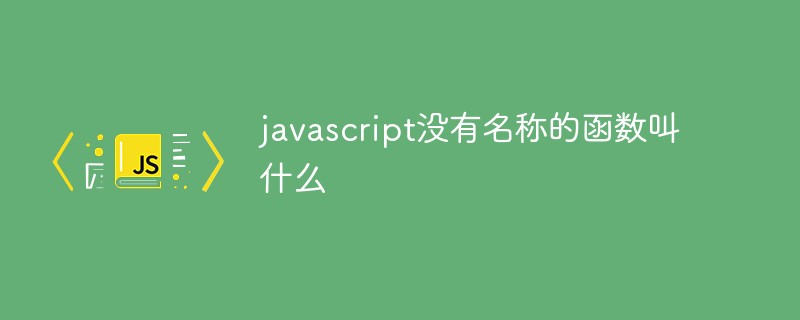
In JavaScript, a function without a name is called an "anonymous function", and the syntax is "function (){}". The functions of anonymous functions: 1. Closure can be realized through anonymous functions; 2. Simulate block-level scope and reduce global variables.

The operating environment of this tutorial: Windows 7 system, ECMAScript version 6, Dell G3 computer.
Anonymous function: A function without an actual name.
First we declare a normal function:
//声明一个普通函数,函数的名字叫fn
function fn(){
console.log("hello world");
}Then remove the name of the function to become an anonymous function:
//匿名函数,咦,运行时,你会发现报错啦!
function (){
console.log("hello world");
}At this point, you will find that running a separate The anonymous function reports an error because it does not meet the syntax requirements! The solution is just to wrap the anonymous function with a bracket:
//匿名函数在其它应用场景括号可以省略
(function (){
//由于没有执行该匿名函数,所以不会执行匿名函数体内的语句。
console.log("hello world");
})If you need to execute the anonymous function, add a bracket after the anonymous function to execute it immediately!
(function (){
//此时会输出hello world
console.log("hello world");
})()If you need to pass a value, just write the parameters directly within the brackets:
(function (str){
//此时会输出hello world!
console.log("hello");
})(" world!")[Recommended learning: javascript advanced tutorial]
Application scenarios of anonymous functions
1, event
<input type="button" value="点我啊!" id="sub">
<script>
//获得按钮元素
var sub=document.querySelector("#sub");
//给按钮增加点击事件。
sub.onclick=function(){
alert("当点击按钮时会执行到我哦!");
}
</script>2, object
var obj={
name:"张三",
age:18,
fn:function(){
return "我叫"+this.name+"今年"+this.age+"岁了!";
}
};
console.log(obj.fn());//我叫张三今年18岁了!3, function expression
//将匿名函数赋值给变量fn。
var fn=function(){
return "我是一只小小小小留下,怎么飞也飞不高!"
}
//调用方式与调用普通函数一样
console.log(fn());//我是一只小小小小留下,怎么飞也飞不高!4, Callback function
setInterval(function(){
console.log("我其实是一个回调函数,每次1秒钟会被执行一次");
},1000);5, return value
//将匿名函数作为返回值
function fn(){
//返回匿名函数
return function(){
return "hello world";
}
}
//调用匿名函数
console.log(fn()());//hello world
//或
var box=fn();
console.log(box());//hello worldImitate block-level scope
if(1==1){//条件成立,执行if代码块语句。
var a=12;//a为全局变量
}
console.log(a);//12
for(var i=0;i<3;i++){
console.log(i);
}
console.log(i);//4if(){}for(){}, etc. do not have their own scope. If it goes out of its own scope, the declared variable will be destroyed immediately. But we can simulate block-level scope through anonymous functions:
(function(){
//这里是我们的块级作用域(私有作用域)
})();Try block-level scope:
function fn(){
(function(){
var la="啦啦啦!";
})();
console.log(la);//报错---la is not defined
}
fn();The role of anonymous functions:
1. Closure can be implemented through anonymous functions. Closure will be explained in the following articles. A quick introduction here: a closure is a function that can access variables defined within the function scope. To create a closure, you often need to use an anonymous function.
2. Simulate block-level scope and reduce global variables. After executing the anonymous function, the corresponding variables stored in the memory will be destroyed, thereby saving memory. Furthermore, in large-scale multi-person development projects, using block-level scope will greatly reduce the problem of naming conflicts, thereby avoiding catastrophic consequences. Developers no longer have to worry about messing up the global scope.
For more programming-related knowledge, please visit: Programming Video! !
The above is the detailed content of What is the name of a function without a name in javascript?. For more information, please follow other related articles on the PHP Chinese website!